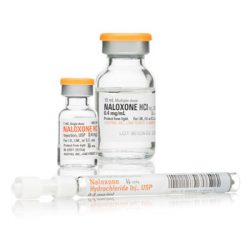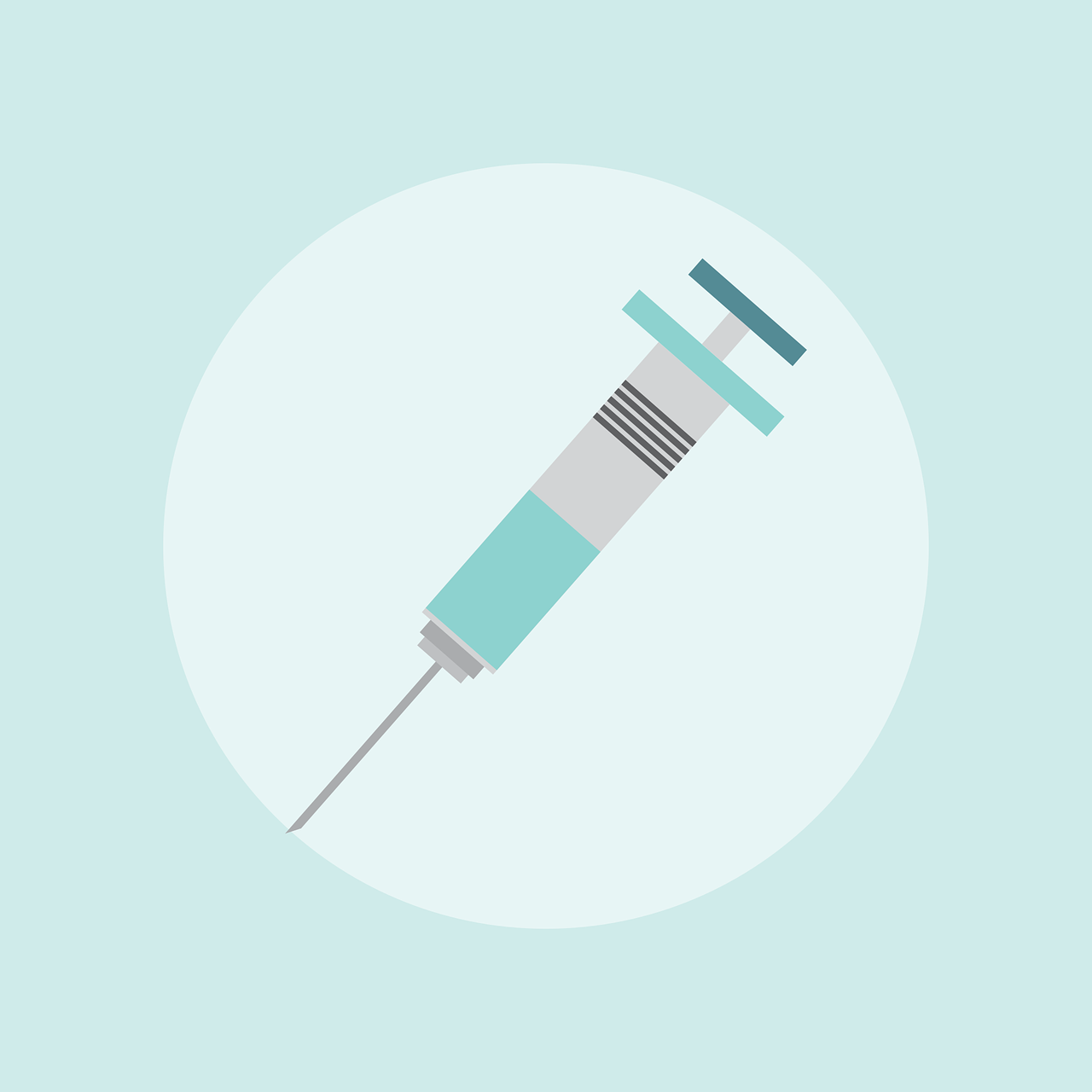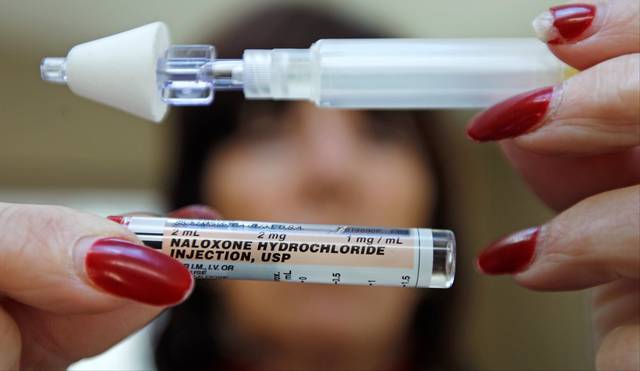Naloxone is a drug that acts on opioid receptors (like prescription and illicit opioids do) but in a different way. It is necessary for reviving patients who have taken high doses of opioid drugs and protecting them from the dangerous effects of these drugs. Naloxone is extremely potent, and its effects are very intense. It should be used only in the case of an emergency. When used correctly, this drug can save the life of an individual who has overdosed on opioids.
Are you looking for opiate addiction treatment? Call us toll free at 800-442-6158 Who Answers? for help today.
What is Naloxone?
According to the the NLM, “Naloxone injection is in a class of medications called opiate antagonists. It… block[s] the effects of opiates to relieve dangerous symptoms caused by high levels of opiates in the blood.” Naloxone is often administered by doctors in the emergency room when a patient undergoing opioid overdose is admitted. This drug can reverse the effects of a high opioid dose, often bringing individuals out of dangerous and deadly physical states.
Naloxone is also marketed in some areas as a drug that individuals may purchase and use in an emergency in order to treat family members and friends who are overdosing on opioid drugs. In addition to these beneficial uses, naloxone is also paired with the partial opioid agonist buprenorphine as the brand name drug Suboxone. This combination medication helps treat opioid addiction and withdrawal.
The common brand name for naloxone administered by injection for overdose victims is Narcan, and Evzio is the brand pre-filled auto-injection device.
How Does Naloxone Work?

Naloxone helps reverse the effects of an opiate overdose.
Opioid antagonists attach to the same receptors that opioid agonists do. The difference is that the connection naloxone and other opioid antagonists make is much stronger than those of partial or even full opioid agonists. Naloxone does not activate the receptor that it attaches to so there is no effect of intoxication.
This is beneficial when a person has overdosed on opioids because the drug itself can block the effects of opioid agonists, given the stronger connection it is able to make with the receptors in the brain. This keeps the deadly effects like respiratory depression at bay so that the individual can be treated more safely.
While some opioid antagonists have partial agonist effects, naloxone does not. That is why it is so safe to use in cases of overdose, as it is able to stop the effects of overdose from occurring and can save a person from fatal opioid overdose, as long as it is administered in a timely fashion.
Treatment can help you or a loved one overcome addiction. Call 800-442-6158 Who Answers? to find treatment today.
What are the Side Effects of Naloxone?
It can be painful to receive a shot of naloxone, especially because the opioid drug the person has overdosed on is causing them to become more desensitized to pain. Because those effects will dissipate when the individual receives the shot, they can experience mild to extreme pain, depending on the situation. However receiving a shot of naloxone is much better and safer than letting the effects of opioid overdose continue unabated.
Some of the other side effects of naloxone are:
- Pain, burning, or redness at the injection site
- Sweating
- Hot flashes
- Flushing of the skin
- Opioid withdrawal symptoms
These symptoms will commonly be experienced by the individual, especially those of withdrawal if they have been abusing opioid drugs. The effects of the opioids will be suddenly kicked out of their system, often leaving them with instant withdrawal. While it can be dangerous, these individuals are able to be cared for in the hospital where they receive the injection. If you need to give an Evzio injection yourself, you should still call 911 and get the individual to the hospital in case of any other issues.
Below are some serious side effects that could occur from naloxone. However, they are not as common as those dangerous and deadly side effects experienced as a result of opioid overdose.
- Rapid, pounding, or irregular heart beat
- Hallucinations
- Loss of consciousness
- Seizures
Clearly, the small risk for serious side effects is worth it to end someone’s near-fatal opioid intoxication. In some instances, babies whose mothers were addicted to and taking opioids during the pregnancy will be treated with naloxone in order to curb any effects of opioid intoxication. They might exhibit “stronger than normal reflexes” or increased crying.
How Do I Give a Naloxone Injection?
If you have a friend or family member who constantly abuses opioids, you should find out whether or not pre-filled naloxone injection devices are legal to carry in your state. According to the Massachusetts Department of Health, there are now programs that can even “train opioid users, their families and their friends on how to prevent and recognize an opioid overdose, and what to do if one occurs.”
If you believe someone you know has overdosed on opioids, the NLM states:
- You must look for the symptoms of overdose including
- Shallow or no breathing
- An inability to wake the individual
- Extremely small pupils
- Skin, mouth, lips, or fingers turning blue
- Call 911 immediately and tell the operator exactly what happened.
- Stay with the individual until help arrives.
- Do not attempt to make the individual vomit.
- If you have the naloxone injection device, follow these steps:
- Inject the drug either into the muscle or under the skin of the individual’s thigh.
- Inject the medication straight into the skin unless it is an emergency. Then it may be injected through the clothes.
- Use a new naloxone injection device if the individual’s symptoms return before help can arrive.
What Does Naloxone Do When Combined with Buprenorphine?
Naloxone and buprenorphine or Suboxone treats opioid dependence and addiction in individuals who need either short- or long-term treatment regimens. These individuals may start off taking buprenorphine alone (brand name Subutex) in order to get them to a stabilized point where they are no longer going through withdrawal. Then the combination of buprenorphine and naloxone is used throughout the extent of their treatment.
Buprenorphine staves off the opioid withdrawal symptoms and cravings but naloxone “guards against misuse” of the drug (FDA). If a person tries to abuse Suboxone by crushing the tablets, naloxone will precipitate withdrawal, causing them to feel all the painful and uncomfortable symptoms immediately. This keeps Suboxone users from abusing the drug.
Is Naloxone Addictive?
No, naloxone is not addictive or habit-forming the way that opioid agonists are. Even buprenorphine, a partial opioid agonist, can be misused because high doses of the drug might cause intoxication. Naloxone does not cause intoxication and also causes many other symptoms which an individual would not want to experience. This is why it is not addictive in nature.
Is Naloxone Dangerous?
A person cannot die from or overdose on high doses of naloxone. Someone may need to be administered a high dose of the drug to combat opioid overdose, but that does not mean that they will overdose on naloxone itself.
According to the Ohio Department of Health, “Numerous studies from the US and Europe demonstrate that naloxone can be safely administered in a nonhospital setting with few serious complications. A 2004 study of 1193 patients found that only 0.03% of overdoses treated with naloxone were associated with serious complications requiring hospitalization.” Relatively speaking, the drug is safe and much safer than opioid drugs taken in high doses.
Is Naloxone an Addiction Treatment?
For the most part, naloxone is not used as a pharmacological treatment for addiction. While the drug is beneficial, its effects are best used for preventing buprenorphine misuse and stopping an opioid overdose. We can help you find opiate addiction treatment. Call 800-442-6158 Who Answers? toll free today.
Naltrexone, another opioid antagonist, is used to treat opioid addiction in some cases (according to Harvard Medical School especially in the cases of “physicians and other middle-class patients who are highly motivated to get free of the opiate because they have so much to lose from a persistent addiction”). While the drug is extremely effective for motivated patients, it is not tolerated by the majority of addicted individuals and most stop taking it.
This is another reason why naloxone cannot be used as an addiction treatment. It would not be tolerated because patients would not feel the effects of the drug on their opioid receptors, thus still causing them to experience cravings. And if they were to relapse, they would experience withdrawal extremely quickly because of naloxone’s effects. Naloxone is best as a means of protecting a patient from deadly overdose before they can begin treatment for their addiction.
Naloxone Saves Lives
Although it is clear that naloxone can potentially save a person who has overdosed on opioids, there are so many other benefits to the drug and what it can help accomplish. A person cannot seek treatment unless they live through the overdose, and “one in four drug users (26.2%) sought treatment within 30 days after their last overdose,” according to a recent study (Ohio Department of Health). A naloxone injection can actually be the first step in helping some realize that they need treatment and to follow through with finding it.
Naloxone is a safe and effective medication for an individual who might otherwise die of overdose. It also causes buprenorphine to be more effective as an addiction treatment. The drug should be carried by friends and family members of those who abuse opioids and used in cases of emergencies, even if an ambulance is on the way (because time is often of the essence in overdose cases). Opioid abuse and addiction is dangerous; in the most dangerous of circumstances, naloxone can help.
You do not have to deal with addiction alone. Call 800-442-6158 Who Answers? for help finding treatment.












